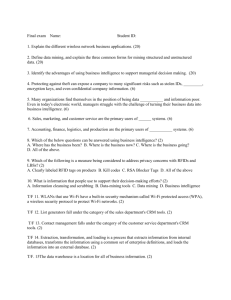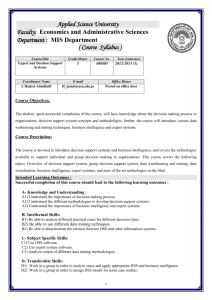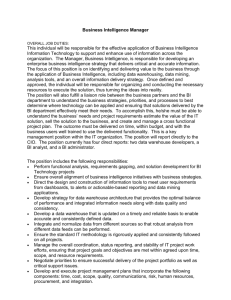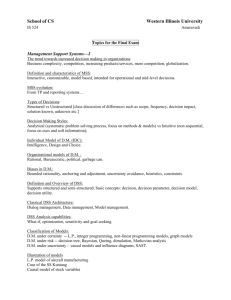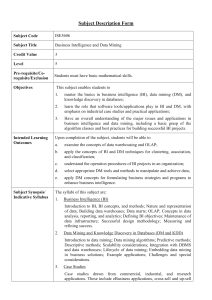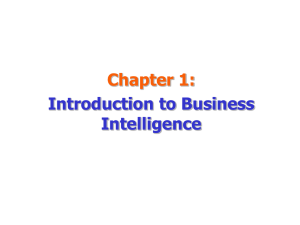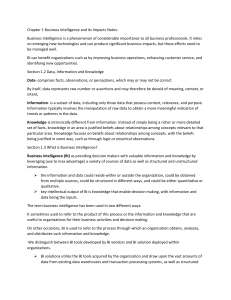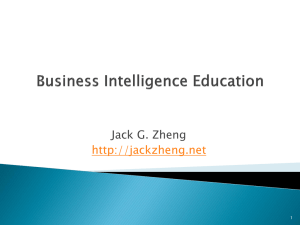Chapter 9
advertisement
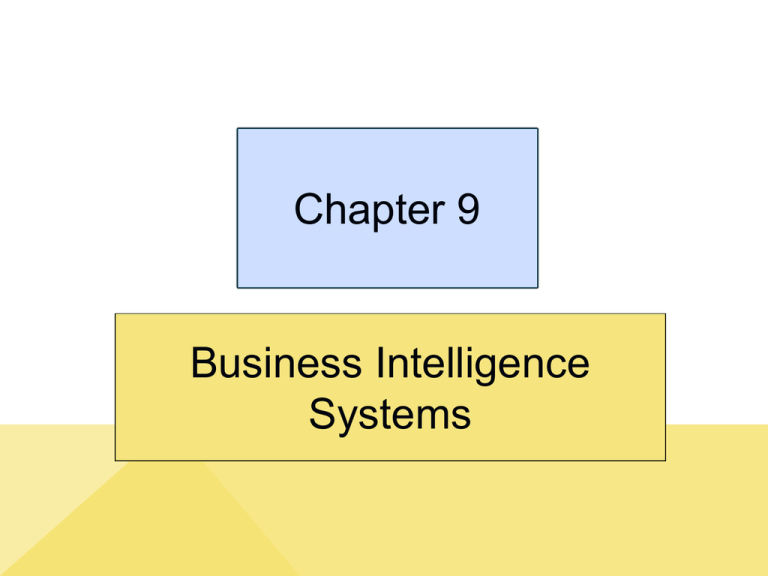
Chapter 9 Business Intelligence Systems Study Questions Q1: How do organizations use business intelligence (BI) systems? Q2: What are the three primary activities in the BI process? Q3: How do organizations use data warehouses and data marts to acquire data? Q4: What are three techniques for processing BI data? Q5: What are the alternatives for publishing BI? 9-2 Business Intelligence • Business intelligence (BI) mainly refers to computer-based techniques used in identifying, extracting, and analyzing business data. • BI technologies - Online analytical processing (OLAP), analytics, data mining, process mining, complex event processing, business performance management, benchmarking, text mining, in-memory computing. • Purpose of BI - provide historical, current and predictive views of business operations. Q1: How Do Organizations Use Business Intelligence (BI) Systems? 9-4 Example Uses of Business Intelligence 9-5 Q2: What Are the Three Primary Activities in the BI Process? 9-6 Using BI for Problem-solving at GearUp: Process and Potential Problems 1. 2. 3. 4. 5. 6. Obtain commitment from vendor Run sales event Sells as many items as it can Order amount actually sold Receive partial order and damaged items If received less than ordered, ship partial order to customers 7. Some customers cancel orders 9-7 Tables Used for BI Analysis at GearUp 9-8 Extract of the Item_Summary Table 9-9 Lost Sales Summary Report 9-10 Lost Sales Details Report 9-11 Event Data Spreadsheet 9-12 Short and Damaged Shipments Summary 9-13 Short and Damaged Shipments Details Report 9-14 Publish Results • Options – Print and distribute via email or collaboration tool – Publish on Web server or SharePoint – Publish on a BI server – Automate results via Web service 9-15 Q3: How Do Organizations Use Data Warehouses and Data Marts to Acquire Data? • Why extract operational data for BI processing? Security and control Operational not structured for BI analysis BI analysis degrades operational server performance 9-16 Functions of a Data Warehouse • Obtain or extract data from operational, internal and external databases • Cleanse data • Organize, relate, store in a data warehouse database • DBMS interface between data warehouse database and BI applications • Maintain metadata catalog 9-17 Components of a Data Warehouse 9-18 Examples of Consumer Data that Can Be Purchased 9-19 Possible Problems with Source Data 9-20 Data Marts Examples 9-21 Q4: What Are Three Techniques for Processing BI Data? Basic operations: 1. Sorting 2. Filtering 3. Grouping 4. Calculating 5. Formatting 9-22 Three Types of BI Analysis 9-23 Unsupervised Data Mining Analysts do not create a priori hypothesis or model before running analysis Hypotheses created after analysis to explain patterns found Apply data-mining technique and observe results Technique: •Cluster analysis to find groups with similar characteristics Technique 2: Dimension reduction Supervised Data Mining Model developed before analysis • Statistical techniques used prediction such as • Regression analysis—measures impact of set of variables on one another Example: CellPhoneWeekendMinutes = 12 X (17.5 X CustomerAge) + (23.7 X NumberMonthsOfAccount) = 12 + 17.5*21 + 23.7*6 = 521.7 BigData • Huge volume – petabyte (1015 Bytes) and larger • Rapid velocity – generated rapidly • Great variety Free-form text Different formats of Web server and database log files Streams of data about user responses to page content; graphics, audio, and video files 9-26 MapReduce Processing Summary Google search logs broken into pieces 9-27 Google Trends on the Term Web 2.0 9-28 Hadoop • Open-source program supported by Apache Foundation2 • Manages thousands of computers • Implements MapReduce – Written in Java • Amazon.com supports Hadoop as part of EC3 cloud offering • Pig – query language 9-29 Q5: What Are the Alternatives for Publishing BI? 9-30 What Are the Two Functions of a BI Server? 9-31 How Does the Knowledge in This Chapter Help You? • Companies will know more about your purchasing habits and psyche. • Singularity – machines build their own information systems. • Will machines possess and create information for themselves? 9-32 Ethics Guide: Data Mining in the Real World Problems: • Dirty data • Missing values • Lack of knowledge at start of project • Over fitting • Probabilistic • Seasonality • High risk—cannot know outcome 9-33 Guide: Semantic Security 1. Unauthorized access to protected data and information – Physical security Passwords and permissions Delivery system must be secure 2. Unintended release of protected information through reports and documents 3. What, if anything, can be done to prevent what Megan did? 9-34 FireFox Collusion 9-35 Ghostery in Use (ghostery.com) 9-36

